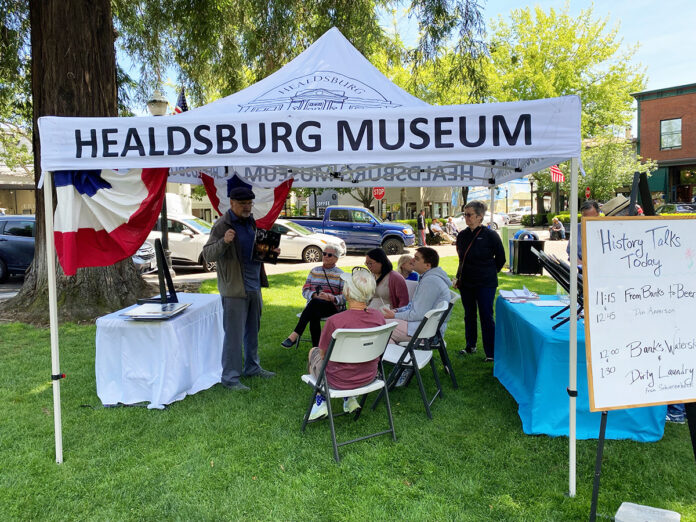
The Healdsburg Museum is dark, but not silent. Though the historic Carnegie building at 221 Matheson will be closed to the public for the next several weeks while they prepare their next exhibition, museum docents and supporters will not be idle.
For the rest of the summer, docents are bringing history to the Plaza with “History Talks,” a series of informal talks every Saturday (Plaza availability permitting) from June through Labor Day. (They will not be offering “History Talks” on June 17, however, as Healdsburg Jazz plans a day-long Juneteenth Celebration to open their 25th annual festival.)
From beneath their white pop-up canopy at the Healdsburg Plaza, from 11am to 2pm on Saturdays, docents will be presenting short illustrated talks about the history and architecture of some of Healdsburg’s favorite buildings, many of which have been given Healdsburg Museum Historical Preservation awards over the last 30 years.
They’ll also be available to answer questions and share some of the town’s most colorful stories with guests. “We have studied up on 15 buildings—seven residential and eight commercial or institutional—to use as examples in our talks relating to architecture.
“Docents will choose a subset of these buildings to discuss since we are trying to keep our talks to about 20 minutes each,” said Joanne Taeuffer, one of the museum’s docents and a board member.
The first History Talk took place on June 10, when docents Don Anderson and Fran Schierenbeck focused on the idea of “adaptive reuse” of buildings—the way buildings are reimagined with new uses to adapt to changes in the town itself. One such building is the old Farmers’ and Mechanics Bank building on Plaza Street, which has evolved through the years to adapt to a changing town.
In coming weeks, other docents will turn their attention to many of the other historic buildings in town and the stories they contain—such as the Neoclassical home at 726 Fitch Street that immigrant Frank Passalaqua built in 1914, or the home on North Street that Ransom Powell built in 1871 which became first a hospital, then a bed & breakfast—now known as Camellia Inn.
Another notable building is the old Sotoyome Machine Shop at 222 Healdsburg Ave., a rare double-Quonset that in the 1960s turned into the plant to manufacture the once-trendy Maharajah water skis and is now the site of the expansive Paul Mahder Gallery.
“We have studied up on 15 buildings—seven residential and eight commercial or institutional—to use as examples in our talks relating to architecture,” said Taeuffer. She added that the participating docents “will choose a subset of these buildings to discuss since we are trying to keep our talks to about 20 minutes each.”
Also available at the museum tent will be materials for two self-guided walking tours of some of the town’s architectural gems, including a tour of seven residences that represent common architectural styles in town and the historic Healdsburg Elementary School, and a tour of 12 commercial buildings in the downtown area.
Meanwhile, the museum staff is preparing their next exhibit, “We Are Not Strangers Here: African-American Histories in California and Healdsburg,” which is expected to open July 20. It’s based on a traveling exhibition that is being contextualized for Healdsburg’s own place in this history.
“We are transforming the gallery to make this an especially compelling exhibition, with design consultation from experiential designer Noah Jeppson,” said museum director Holly Hoods.







